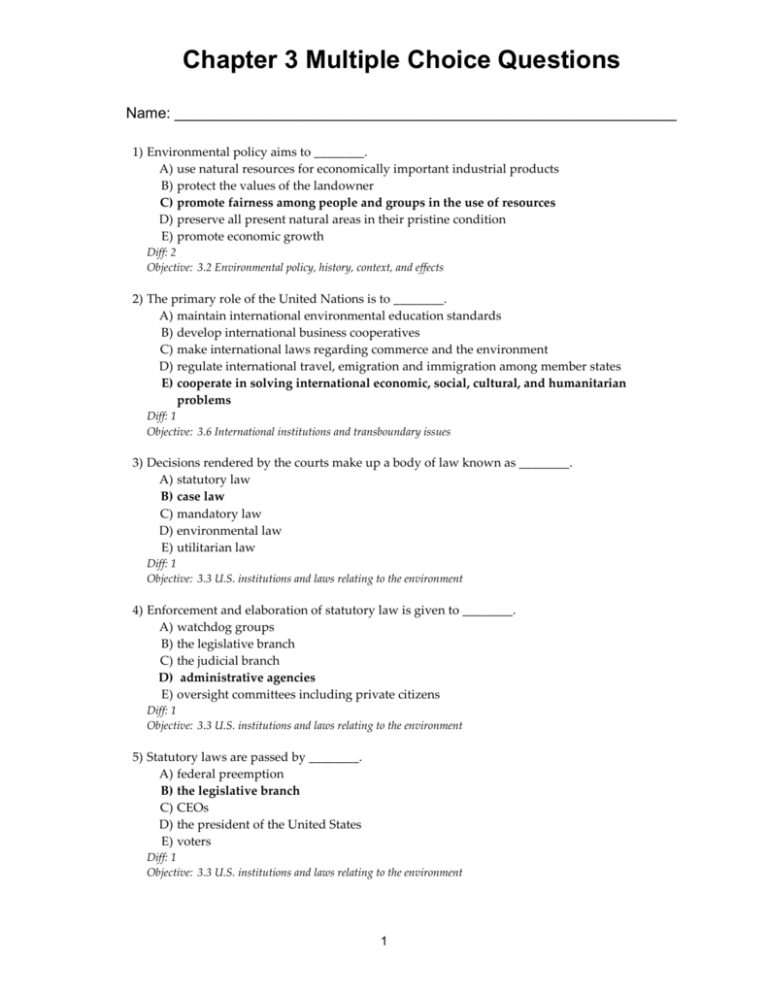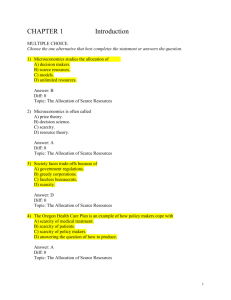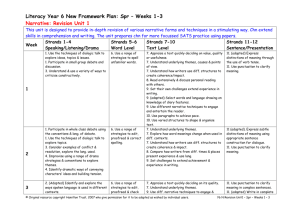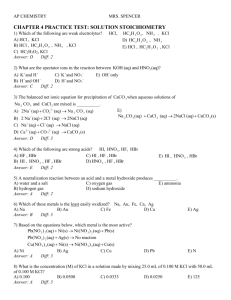Chapter 3 Multiple Choice Questions (Answers - science-b
advertisement

Chapter 3 Multiple Choice Questions Name: ____________________________________________________________ 1) Environmental policy aims to ________. A) use natural resources for economically important industrial products B) protect the values of the landowner C) promote fairness among people and groups in the use of resources D) preserve all present natural areas in their pristine condition E) promote economic growth Diff: 2 Objective: 3.2 Environmental policy, history, context, and effects 2) The primary role of the United Nations is to ________. A) maintain international environmental education standards B) develop international business cooperatives C) make international laws regarding commerce and the environment D) regulate international travel, emigration and immigration among member states E) cooperate in solving international economic, social, cultural, and humanitarian problems Diff: 1 Objective: 3.6 International institutions and transboundary issues 3) Decisions rendered by the courts make up a body of law known as ________. A) statutory law B) case law C) mandatory law D) environmental law E) utilitarian law Diff: 1 Objective: 3.3 U.S. institutions and laws relating to the environment 4) Enforcement and elaboration of statutory law is given to ________. A) watchdog groups B) the legislative branch C) the judicial branch D) administrative agencies E) oversight committees including private citizens Diff: 1 Objective: 3.3 U.S. institutions and laws relating to the environment 5) Statutory laws are passed by ________. A) federal preemption B) the legislative branch C) CEOs D) the president of the United States E) voters Diff: 1 Objective: 3.3 U.S. institutions and laws relating to the environment 1 6) The judicial system is important for environmental policy because ________. A) grassroots and other nongovernmental organizations have brought lawsuits to correct environmental damage B) it regulates administrative agencies C) it mandates that environmental law preempt all other federal laws D) it allows corporations in the United States to disregard the environmental laws of other countries E) its purpose is to assist corporations to negotiate with the legislative branch Diff: 1 Objective: 3.3 U.S. institutions and laws relating to the environment 7) The takings clause means that ________. A) the government can cause environmental damage without compensation B) private citizens can take value from public land by mining, timbering, or similar activities C) natural resources cannot be taken without payment D) state entities can take private property for less than market value E) private property shall not be taken for public use without just compensation Diff: 1 Objective: 3.3 U.S. institutions and laws relating to the environment 8) A regulatory taking ________. A) means that the government can cause environmental damage without being subject to regulations B) means that the government does not take possession of the property but deprives the owner of most of its economic value C) takes property without allowing for compensation for natural resources D) removes environmental regulations from individual owners Diff: 1 Objective: 3.3 U.S. institutions and laws relating to the environment 9) The environmental justice movement is ________. A) currently required by most legislative bodies as they consider new laws B) based on the notion of fairness toward people of all races, cultures, and economic backgrounds C) provided for by the income from green taxes D) currently illegal in most states E) comprised of lawyers and judges concerned with environmental issues Diff: 1 Objective: 3.3 U.S. institutions and laws relating to the environment 10) The first laws in U.S. environmental policy ________. A) were passed as early as 1980 B) dealt primarily with management of private land C) were intended to promote settlement of the West D) were to preserve endangered species E) were to reduce pollution caused by early industrial efforts Diff: 1 Objective: 3.2 Environmental policy, history, context, and effects 2 11) The Mineral Lands Act of 1866 ________. A) has been subjected to major overhauls in the last century B) provided no governmental oversight to mining in the United States C) provided free equipment to promote mining in the West D) ensured that mining operations would repair and restore an area when they were done E) allowed mining companies to drill on land held by private citizens without needing to compensate them Diff: 1 Objective: 3.2 Environmental policy, history, context, and effects 12) The first national park in the world was ________. A) Yosemite B) Yellowstone C) Grand Canyon D) Glacier National Park E) Death Valley Diff: 1 Objective: 3.2 Environmental policy, history, context, and effects 13) Rachel Carson's book Silent Spring, published in the 1960s, ________. A) awakened the American public to negative effects of artificial hormones B) was the beginning of the first wave of U.S. environmental policy C) focused on chemical pollutants, including industrial chemicals D) warned of insect pollinator losses through pesticide use E) was concerned with birth defects in humans Diff: 1 Objective: 3.2 Environmental policy, history, context, and effects 14) The National Environmental Policy Act (NEPA) ________. A) was signed into law by Bill Clinton B) requires compensation to be given to anyone harmed by deliberate pollution from any business or corporate entity C) altered the amount of chemicals allowed in water as a result of industrial pollution D) put all federal land under stringent environmental protection E) required environmental impact statements for any projects funded by the U.S. government Diff: 1 Objective: 3.3 U.S. institutions and laws relating to the environment 15) Water law in the United States ________. A) is currently left entirely to the federal government B) was altered in the 1800s by the Clean Water Act C) changed in response to the hurricane damage to the Gulf Coast in 2005 D) is intended to protect water quality E) is intended to encourage water usage by agriculture for improved crops Diff: 1 Objective: 3.3 U.S. institutions and laws relating to the environment 3 16) To control pollution, industry has been given limits and been threatened with punishment if these limits are violated. This approach is called ________. A) end of the alley B) carrot and stick C) command and control D) limit and manage E) last chance Diff: 1 Objective: 3.4 Environmental policy approaches 17) The Green Scissors report ________. A) compiles data on tax laws that encourage or shelter polluters B) reported that less than $1 million is spent annually on environmentally harmful subsidies C) is a publication of conservative, right-wing groups interested in cutting government D) is an annual governmental publication E) compiles data on environmentally harmful subsidies Diff: 1 Objective: 3.4 Environmental policy approaches 18) The sewage found in the Tijuana river watershed was/is ________. A) caused primarily by Mexican-owned maquiladoras B) a transboundary problem C) caused by the pressure on American companies to hire American workers D) easy to legislate once the causes were found E) dramatically improved once subsidies were in place Diff: 1 Objective: 3.1 Relationships: science, ethics, economics, and policy 19) The revolving door ________. A) allows lobbyists to work for many political entities at the same time B) is the movement of powerful officials between the private sector and government agencies C) is illegal in most states D) pairs environmental causes with lobbyists already working on other causes E) allows corporate heads to work together on political legislation Diff: 1 Objective: 3.5 Environmental policy process and effectiveness 20) International environmental law arises from ________. A) democratic voting procedures to choose and ratify laws B) informal agreements reached by multinational corporations C) bidding on subsidies D) distribution and use of pollution permits E) international conventions or treaties Diff: 1 Objective: 3.6 International institutions and transboundary issues 4 21) The UNEP ________. A) is the environmental arm of the United Nations B) has a mission of economic development C) has three subsections that govern international laws, treaties, and regulations D) is a federal agency based in Washington, D.C. E) is primarily concerned with the education of children on environmental issues Diff: 1 Objective: 3.6 International institutions and transboundary issues 22) Juanita and Sam attend a beach party and notice that the local beach appears to have a great deal more trash washed up on shore than it did when they were young. The water doesn't appear nearly as clear, and there seems to be less evidence of small water creatures living in the shallows. An afternoon at the local library convinces them that one major cause is the new factory nearby. After some discussion, they decide their next step should be ________. A) identifying the problem B) identifying the cause of the changes C) talking to a local environmental group about solutions D) lobbying their elected representatives to complain about the problem E) picketing the guilty factory Diff: 2 Objective: 3.5 Environmental policy process and effectiveness 23) The entire environmental policy process ________. A) includes more steps than the average citizen is able to accomplish alone B) can be accomplished by anyone acting alone C) is only accessible to wealthy individuals D) can only be completed by the major political parties E) can only be completed by paid political lobbyists Diff: 2 Objective: 3.5 Environmental policy process and effectiveness 24) The World Bank was established in 1944 to ________. A) provide ease of banking for multinational corporations B) fund economic development for all countries, rich and poor, including dams and irrigation in the poorest countries, for the poorest peoples C) fund international projects for developed nations, including dams on international rivers, multicountry irrigation projects, and the spraying of herbicides and insecticides D) fund international environmental studies of issues such as pollution and global warming E) help weak governments by loaning money to heads of state for military infrastructure Diff: 2 Objective: 3.6 International institutions and transboundary issues 25) Critics of the World Trade Organization ________. A) charge that it gives too much money to environmental causes B) complain that it frequently worsens environmental problems C) complain that it shapes environmental policy by establishing unfair international laws D) say that the international taxes that it regulates are burdensome to smaller countries E) charge that the WTO's subsidy policies unfairly target poor people Diff: 2 Objective: 3.6 International institutions and transboundary issues 5 26) Lobbying, legal action and campaign funding are all means used by ________ to influence governmental environmental policies. A) the public sector B) social science studies C) the scientific community D) the judicial branch of government E) the legislative branch Diff: 2 Objective: 3.2 Environmental policy, history, context, and effects 27) Norman Myers points out that government subsidies are often ________. A) used to support sustainable development B) used to support underfunded, struggling businesses C) influential in promoting efficiency and waste reduction D) supporting activities and businesses that are environmentally harmful E) initiated by environmentalist lobbying Diff: 2 Objective: 3.5 Environmental policy process and effectiveness 6








